Join More Than 50,000+ Subscribers and get latest camera news and rumors
NEW CAMERA VIDEOS ON YOUTUBE
|
By admin, on May 11th, 2014
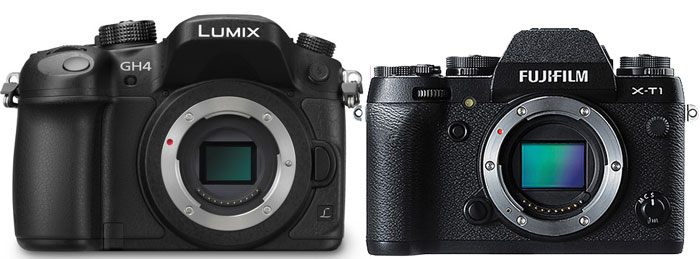 Real size comparison – Fuji have smaller body and big sensor Real size comparison – Fuji have smaller body and big sensor
Panasonic GH4 vs Fuji X-T1, the X-T1 is flagship camera from fuji and Panasonic GH4 is a flagship camera from Panasonic, before we start the comparison I must say that Panasonic GH4 have better video capturing mode and resolution compared to X-T1.. but Fuji have very strong core specification for still shooters.. take a look below for more details
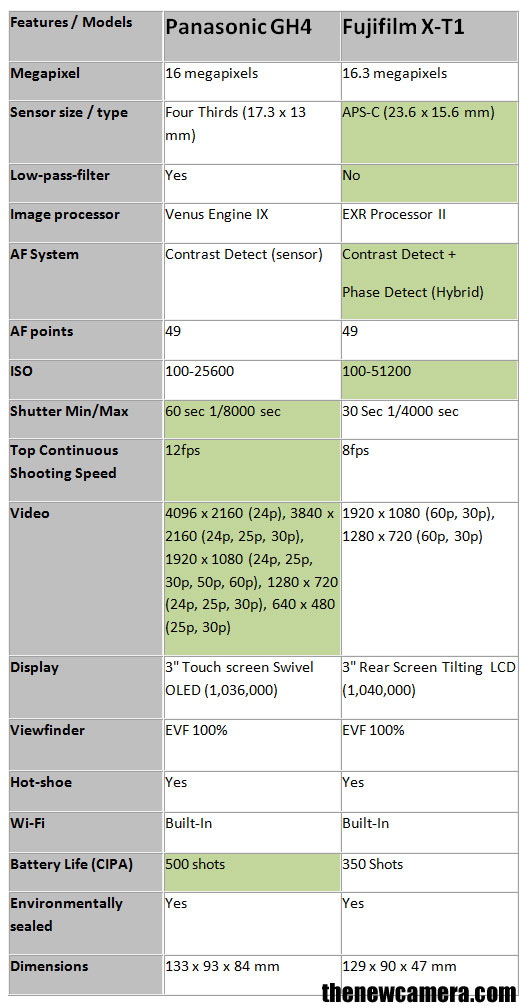
Sensor:
Fuji have bigger sensor, the APS-C sensor have more surface area to collect light compared M4/3 format based sensor, hence Fuji will give better image quality and more dynamic range due to bigger sensor size.
No Low-pass filter – Fuji features 16.3MP APS-C X-Trans CMOS II Sensor, the X trans sensor doesn’t need a external low-pass filter hence it will produce sharper still images compared to Panasonic GH4 at 100%.
PDAF architecture – The Fuji X-T1 system have built-in phase AF points inside the sensor, due to PDAF technology the camera have HYBRID AF system inside, the Panasonic GH4 is limited to contrast based AF system.
ISO Range: Fujifilm X-T1 ISO range starts from 100 to 51200, the GH4 ISO range is limited to 25600 only.
From the above we conclude that Fuji X-T1 will produce better Image Quality and also have advance AF system than Panasonic GH4.
Video:
Professional 4K Video Recording in GH4 – The Panasonic GH4 records 4K video, 16:9 UHD 4K 3840×2160 video at 23.98p, 24p or 29.97p, and 17:9 DCI (Digital Cinema Initiatives) 4K 4096×2160 videos at 24p. with MOV, MP4, MPEG-4 AVCHD recording formats.
Fujifilm X-T1 is limited to Full HD Video recording with 60fps frame rate, recording format H.264, MOV.
Others
Shutter: Panasonic GH 4 have fast continuous shooting speed and shutter range.
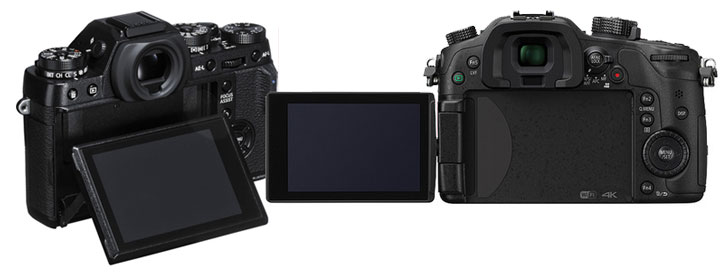
Display: I like the display unit of Panasonic GH4 camera, the GH4 moves in multiple direction on the other hand X-T1 display unit have limited flexibility.
Both camera built with Magnesium Alloy metal, you get a Weather Sealed Body to shoot in all conditions.
Both camera have built-in wireless connectivity
Verdict: Fujifilm X-T1 have better Sensor and AF system, but Panasonic GH4 have 4K video recording option, for still shooters we highly recommend you to buy FujiX-T1 on the other hand Panasonic GH4 is recommended for Videographers.
Buy Panasonic GH4 at Amazon| from B&H
By admin, on April 19th, 2014
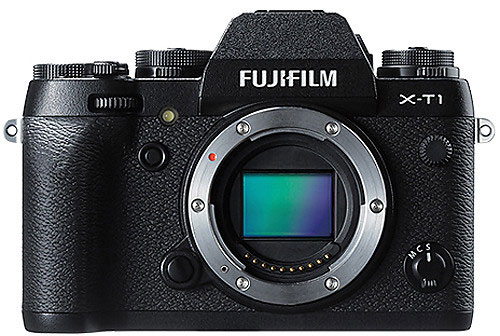
The X-T1 features 16.3 megapixel APS-C X-Trans CMOS II sensor and the X-Trans architecture based sensors doesn’t require / need low pass filter inside the, so you will get sharpness + all details at 100% when best available lenses used with X-T1. The sensor features ISO range upto 100-51200 and top continuous shooting speed up to 8fps.
The X-T1 comes with HYBRID AF SYSTEM that combines phase and contrast based technologies, Digital Split Image and Focus Highlight Peaking are two tech present in X-T1 help you when you are using manual focus.
SO from above details it is very clear that the X-T1 is a excellent machine and will give you desired output when you will use recommended set of lenses used…
Best Wide Angle Lens [Prime]
Fujifilm XF 14mm f/2.8 R Ultra Wide-Angle Lens
| Fujifilm XF 14mm f/2.8 R |
Key Points |
Shop From |
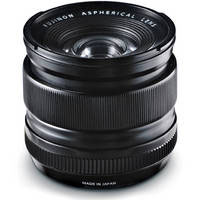 |
The XF 14mm f/2.8 lens features high-quality optics and an extreme wide-angle perspective to cover the entire composition.Best Wide angle lens available for Fuji X series mirrorless camera |
AmazonB&H |
Continue reading Fuji X-T1 Recommended Lenses
By admin, on April 17th, 2014
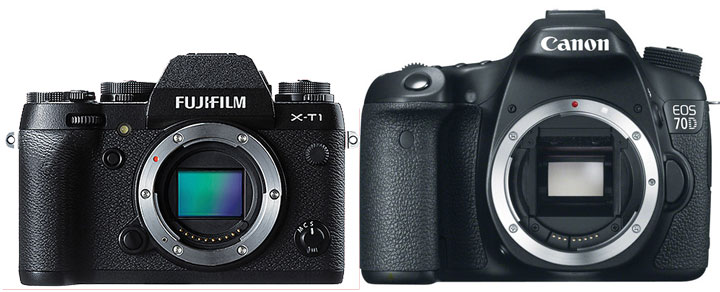
Fujifilm X-T1 vs Canon 70D, Fujifilm X-T1 is a high-end mirrorless camera and Canon 70D is a high-end DSLR camera, take a look at the comparison below
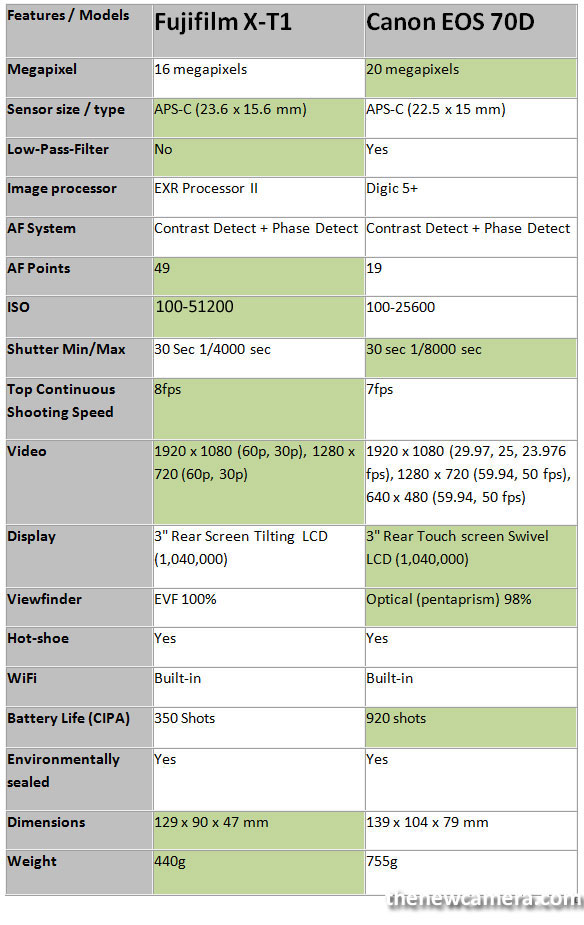
Sensor
Fujifilm X-T1 features X-trans AF sensor with dedicated phase AF points in it + due to bespoke pixel array design the X-T1 doesn’t need low-pass filter.
Canon 70D have Dual-pixel AF sensor with dedicated Phase AF points with the sensor, but sensor architecture is traditional and it does need low-pass filter.
AF system:
Both camera supports Hybrid AF system, Canon 70D is limited to 19 AF point only, Fujifilm X-T1 AF area is divided into a 49-point matrix and covers more screen area compared to Canon 70D.
Digital Split Image technology in X-T1 it make a bridge between Manual focus and Autofocus method, through the implementation of four striped focusing aids; similar to a rangefinder focusing method, once all the four strips are lined, it means focus is acquired and you can press the shutter button.
ISO
We have noticed few things that will surely have impact on low-light perofrmance
Fujifilm X-T1 have bit bigger sensor size compared to Canon 70D.
Fujifilm X-T1 have less megapixel count + bigger sensor, that clearly means the X-T1 photodiodes are larger than Canon 70D. The larger photodiodes collect more incoming light to sensor.
Finally, more expandable ISO range on specification sheet, (25600 vs 51200)
The Fujifilm X-T1 will perform better in low-light situation compared to 70D.
Video:
Fujifilm X-T1 can capture Full HD videos @ 60fps frame rate on the other hand Canon 70D is limited to 30fps frame rate.
Display:
The Canon have better display system compared to Fujifilm X-T1, with Canon you get ability to touch and shoot your subject and swivel LCD helps you to compose your shot effortlessly.
Both camera features Built-in wireless connectivity
Verdict: We highly recommend you to buy Fujifilm X-T1, since it comes with better sensor , no optical low pass filter and advance AF system.
Buy Fujifilm X-T1 from Amazon || B&H
Canon 70D at Amazon | B&H |
By admin, on April 14th, 2014
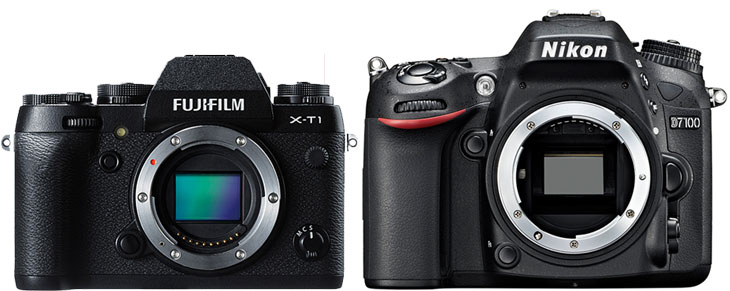
Fujifilm X-T1 is a mirrorless camera and Nikon D7100 is a Pro DSLR, both features excellent core specification .. take a look at the major difference below

Nikon D7100 have more resolution compared to Fujifilm X-T1 but, the X-T1 offers more ISO range hence you get better low light images with X-T1 compared to Nikon D7100.
PDAF sensor in Fujifilm X-T1: The Fujifilm X-T1 comes with phase AF pixels within the sensor, the X-T1 quickly acquire focus during still, video or live view shooting, on the other hand the Phase AF of Nikon D7100 is active when you are using optical viewfinder otherwise during live-view mode and video mode only contrast AF is active.
Fujifilm X-T1 offers fast continuous shooting speed compared to Nikon D7100, but Nikon D7100 offers better shutter range ( 1/4000 vs 1/8000).
Fujifilm X-T1 offers tilting screen and you get a better option to compose your image compared to Nikon D7100.
Nikon D7100 offers optical viewfinder and better battery life compared to Fujifilm X-T1.
Built-In Wi-Fi Connectivity: Fujifilm X-T1 features built in WiFi connectivity on the other hand Nikon D7100 require WU-1a Wireless Mobile Adapter to enable WiFi connectivity.
Verdict: Fujifilm X-T1 offers better sensor and fast continuous shooting speed and on the other hand Nikon D7100 have more resolution + huge range of DX and FX lenses and Built-in i-TTL Flash and Speedlight Compatibility.
Finally, We recommend you to buy Fujifilm X-T1 based on specification comparison review.
Buy Fujifilm X-T1 from Amazon || B&H
Buy Nikon D7100 from Amazon | B&H
By admin, on February 2nd, 2014
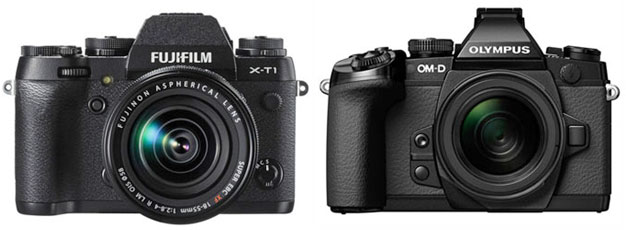
The Fujifilm X-T1 is latest camera from fuji X-series mirrorless system and on the other hand the OMD E-M1 is flagship camera of digital OMD series, the basic and most common difference between these two camera is the size of the sensor, the Fujifilm X-T1 features a large APS-C size sensor and Olympus E-M1 have M4/3 Size sensor.
For more detailed specification take a look at the detailed specification comparison review below…
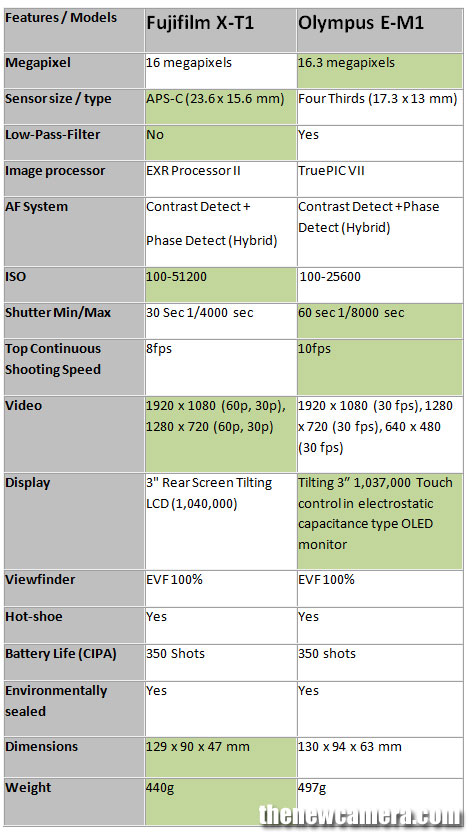
Sensor: Fujifilm X-T1 features a 16 megapixel X-Trans CMOS sensor, the X-Trans bespoke pixel array, the sensor is designed with a randomized pixel pattern that completely eliminate the need of an optical low-pass filter without moiré and aliasing problems.
Olumpus E-M1 Comes with a Four Third format sensor, the sensor is smaller and will not perform as X-T1 camera in-terms of noise and dynamic range.
ISO Range of X-T1 is one stop more than Olympus E-M1, so you will sure get less noise in X-T1 images.
AF system: Both autofocus system that employs both contrast- and phase-detection methods / Both sensor have built in phase AF points so you get fast Auto Focus speed during still and video shoot.
Shutter: The Olympus E-M1 have upper hand here since you get better shutter range and fast top continuous shooting speed compared to fujifilm X-T1.
Image Stabilization: The Olympus E-M1 have built in Image stabilization, it compensates for camera movements up to five shutter speed steps. The five axis work in vertical angle rotation, horizontal angle rotation, horizontal shift, vertical shift, and rolling camera shake movements.
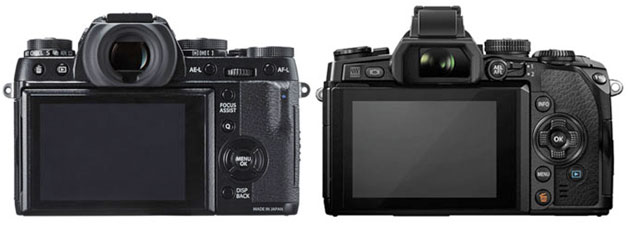
Display:: The X-T1 features 3.0″ 1,040k-Dot Tilting LCD Monitor and on the other hand Olympus E-M1 3.0″ 1,037k-Dot Tilting LCD Touchscreen, so Olympus wins here.
Both camera features rugged body and built-in WiFi Connectivity.
Verdict: The Fujifilm X-T1 will give you bigger sensor, more ISO range, no optical low pass filter for super sharp images and better video mode, on the other hand the E-M1 will give you bit fast shutter speed and built-in 5 axis image stabilization.
We recommend you to buy Fujifilm X-T1.
Buy Fujifilm X-T1 from Amazon || B&H
Buy Olympus E-M1 from Amazon || B&H
By admin, on January 28th, 2014
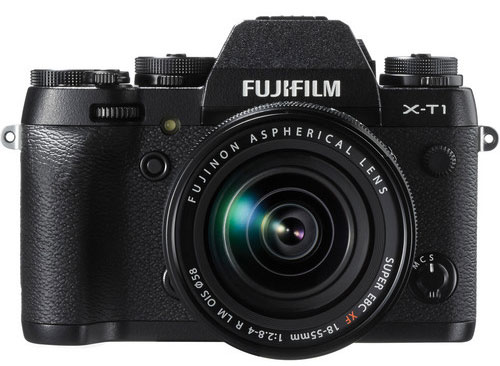 Fujifilm X-T1 available for pre-order at Amazon and B&H, the X-T1 comes with 16.3MP APS-C X-Trans CMOS II Sensor, Hybrid AF System, Continuous Shooting up to 8 fps, 0.5″ and captures Full HD 1080p Video Recording at 60 fps, on the back side we have a decent 2.360k-Dot OLED Viewfinder and a 3.0″ 1,040k-Dot Tilting LCD Monitor. Fujifilm X-T1 available for pre-order at Amazon and B&H, the X-T1 comes with 16.3MP APS-C X-Trans CMOS II Sensor, Hybrid AF System, Continuous Shooting up to 8 fps, 0.5″ and captures Full HD 1080p Video Recording at 60 fps, on the back side we have a decent 2.360k-Dot OLED Viewfinder and a 3.0″ 1,040k-Dot Tilting LCD Monitor.
Now take a look at the pre-order options
Pre-order Fujifilm X-T1 from Amazon [with lens and without lens both options available]
Pre-order Fujifilm X-T1 body from B&H
Pre-order Fujifilm X-T1 body + kit lens from B&H
By admin, on January 28th, 2014

The long rumored Fujifilm X-T1 camera announced today, the camera features 16MP X-Trans CMOS II sensor, no optical low pass filter, the standard ISO range of Fuji X-T1 is ISO200 – 6400, extended ISO 100, 12800, 25600,and 51200. The X-T1 become World’s fastest mirrorless camera featuring a AF speed of 0.08 sec, Startup time of 0.5 sec, Shooting interval of 0.5 seconds. The Fuji X-T1 continuous shooting speed is 8 frames per second with active Hybrid AF (that includes phase and contrast), on the rear side we have High-precision 2.36 million dot OLED viewfinder and 3″ tilting touch screen with 1.4m pixels resolution.
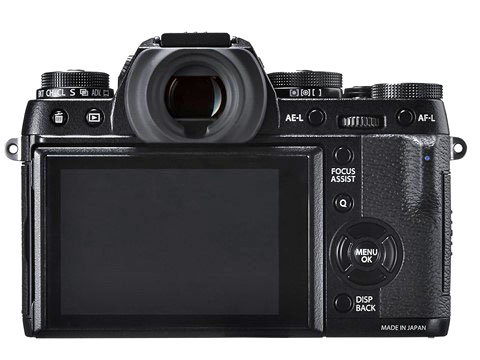
The X-T1 Dust and water-resistant body comes with more than 75 points of weather sealing. Freeze resistance to -14°F
Fujifilm will also weather-resistant zoom lenses in 2014, XF18-135mm F3.5-5.6 R OIS WR, XF16-55mmF2.8 R OIS WR and the XF50-140mmF2.8 R OIS WR.
FUJIFILM X-SERIES REACHES A NEW PEAK WITH WEATHER RESISTANT X-T1
X-T1 features a huge, real-time OLED viewfinder, extreme AF speed, and premium craftsmanship for photographic freedom anywhere
Valhalla, N.Y., January 27, 2014 – As a leader in advanced digital camera technology and outstanding image resolution, FUJIFILM North America Corporation today announced the new FUJIFILM X-T1, a weather-resistant premium interchangeable lens camera with a large OLED electronic viewfinder (EVF) that delivers a near-instant image preview, the latest generation 16.3 Megapixel APS-C X-Trans CMOS II sensor and the segment’s fastest autofocus of 0.08 seconds1 for a truly remarkable photographic experience anywhere.
The FUJIFILM X-T1 now gives professional and enthusiast photographers the award-winning imaging power of the X-Series in a water, dust and temperature resistant body that braves outdoor challenges like never before.
OLED viewfinder perfection
The FUJIFILM X-T1 combines a unique wide-angle 2.36m dot resolution OLED view with the world’s highest magnification (0.77x) for a digital camera 2 and shortest display lag-time of just 0.005sec3 to react as quickly as you need in any environment.
The OLED viewfinder also includes cutting-edge technology to bring users even closer to their subjects. The X-T1’s viewfinder uses a newly designed Graphic User Interface that provides an exciting shooting experience with clear details and a comfortable at-a-glance view of your settings.
The X-T1 has four OLED EVF Display Modes:
- “FULL” mode takes full advantage of the high magnification ratio of the X-T1’s viewfinder to give an unrivalled view of the scene
- “NORMAL” provides an optimum view, including shooting settings
- “DUAL” is specially designed for manual focusing with a clever split view. The regular view and manual focus area can be simultaneously checked (with Digital Split ImageTM or Focus Peak Highlight)4
- “PORTRAIT” view in “NORMAL” and “FULL” modes automatically rotates the displayed information when the camera is held vertically
Award-winning 16.3 Megapixel APS-C X-Trans CMOS II sensor and EXR Processor II
The FUJIFILM X-T1 uses the award-wining EXR Processor II and X-Trans™ CMOS II sensor with built in phase detection that delivers an astonishing response time of just 0.08 seconds and a super-fast 0.5 second start-up time5, along with a 0.05 second shutter time lag and a 0.5 second shooting interval6.
The X-T1 can also shoot up to 8 frames per second7 with tracking AF and is the first-ever CSC8 to be compatible with SDXC UHS-II format memory cards for data writing speed (in Continuous Mode) that is approximately twice that of a conventional SD card.
Tough, weather-resistant design
The FUJIFILM X-T1 is the first weather-resistant X-Series CSC (when used with a weather-resistant lens) that performs in a wide range of challenging environments. The X-T1 uses more than 75 points of weather sealing, and the camera body is dust-resistant and water-resistant. The X-T1 is also freezeproof to -14°F for full-fledged field photography work, while the premium clear 3” LCD screen with 1.04 million dot resolution is made of tempered glass for additional outdoor protection.
Traditional handling, modern response
With five mechanical dials on the top-plate, two command dials; one on the front and one on the rear, and six fully customizable function buttons, the FUJIFILM X-T1 feels and functions like a proper photographic tool in the hand. The top-plate includes two machined-aluminum double-deck dials for the shutter speed and metering, and the ISO sensitivity and drive modes, and each is designed to turn with a reassuring click, while their textured surfaces gives a firm confirmation when setting up a shot.
With their exposure values clearly marked, the X-T1’s settings can be checked at a glance without using the rear LCD and the dials are perfectly arranged so that functions can be changed without removing your eye from the viewfinder. The six customizable function buttons and two command-dials arranged on the front and rear complete the picture, ensuring instant setting satisfaction.
WiFi and remote camera operation
The X-T1 one-touch WiFi connectivity lets you easily share images to your smartphone or tablet – pictures that these devices cannot capture – and remote shooting via smartphone or tablet using the Fujifilm Camera Remote app for unique capture opportunities.
Additional grip and weather resistant lenses
The optional vertical battery grip (VG-XT1) has the same hardy structure as the X-T1, so when added to the body, it is completely secured against the elements.
Fujifilm is launching three weather-resistant zoom lenses to complement the X-T1 camera in 2014, including the XF18-135mmF3.5-5.6 R OIS WR, XF16-55mmF2.8 R OIS WR and the XF50-140mmF2.8 R OIS WR.
FUJIFILM X-T1 key features list:
- 16.3 million Megapixels APS-C X-Trans CMOS II Sensor
- Dust and water-resistant body with more than 75 points of weather sealing. Freeze resistance to -14°F
- EXR Processor II
o World’s fastest AF of 0.08 seconds
o Startup time of 0.5 seconds
o Shutter time lag of 0.05 seconds
o Shooting interval of 0.5 seconds
o Phase detection AF and motion predictive AF for continuous shooting up to 8 frames per second
- High-precision 2.36 million dot OLED viewfinder
o Highest viewfinder magnification for digital cameras of 0.77x
o Wide viewing angle (diagonal 38° and horizontal 31°)
o Ultra-fast Real Time Viewfinder with a lag-time of 0.005sec (less than 1/10 of existing models)
- Four different display modes: Full, Normal, Dual and Vertical.
o Full mode: Displays shooting information at the top and bottom of the screen to avoid obstruction of the view
o Dual mode: Adds a small second screen for checking focus point with Focus Peak Highlight or Digital Split Image
o Normal mode: Lets you concentrate on framing the shot in Auto Focus mode while keeping you aware of how the shooting conditions are changing, making it the perfect setting for sports and action photography
o Portrait mode: When in Full or Normal modes, it rotates the shooting information interface when the camera is turned vertically
- Tempered glass 1.04 million dot high-precision 3” tilting LCD monitor
- Digital Split Image and Focus Highlight Peaking
- World’s first compatibility with Ultra High Speed UHS-II SD memory cards
- Vertical battery grip VG-XT1 and three new zoom lenses offer the same weather resistance to secure the entire system
- Redesigned circuit board design enables high ISO 51200 setting
- ISO200 – 6400, extended ISO 100, 12800, 25600, Auto(maximum ISO setting from ISO 400 – ISO6400 available)
- Lens Modulation Optimizer technology maximizes each lens’ performance
- In-camera RAW converter
- Die-cast magnesium body provides a sturdy and durable, while compact and lightweight design
- Body and grip designed for correct balance when attaching telephoto and large-diameter lenses
- Two command dials and six Function buttons for instant control and customization
- Interval timer shooting for Time Lapse photography is available with intervals of 1 second to 24 hours and up to 999 frames
FUJIFILM X-T1 accessories:
- Dedicated all-leather case BLC-XT1 New
- Vertical battery grip VG-XT1 New
- Hand Grip MHG-XT New
- Four dedicated flash models to choose from depending on requirements (EF-X8 New, EF-X20, EF-20, EF-42)
- Protector filters (PRF-39, PRF-52, PRF-58, PRF-62 and PRF-72 (For XF10-24mmF4 R OIS) New)
- DC coupler CP-W126 NEW
- AC adapter AC-9V NEW
- M Mount Adapter for additional lens compatibility
- Remote release RR-90
- Stereo Microphone MIC-ST1
The FUJIFILM X-T1 (body only) will be available for $1,299.95, and the X-T1 with the XF18mm-55mm (27-84mm) F2.8-4 lens (kit) will be available for $1699.95, both in February 2014.
The FUJIFILM X-T1 uses the same FUJIFILM X-Mount as the X-Pro1, X-E2, X-E1, X-M1 and X-A1, and all FUJIFILM XF and XC lenses work with all X-Series interchangeable lens cameras.
The current Fujifilm lens family includes the following FUJINON XF and XC lenses:
- XF 14mm F2.8 R
- XF 18mm F2.0 R
- XF 23mm F1.4 R
- XF 27mm F2.8
- XF 35mm F1.4 R
- XF 56mmF1.2 R
- XF 60mm F2.4 R Macro
- XF10-24mmF4 R OIS
- XF 18-55mm F2.8-4.0 R LM OIS
- XF 55-200mm F3.5-4.8 R LM OIS
- XC 16-50mm F3.5-5.6 OIS
- XC 50-230mm F4.5-6.7 OIS
Fujifilm X-T1 Specifications
| Number of effective pixels |
16.3 million pixels |
| Image sensor |
23.6 mm x 15.6 mm (APS-C) X-Trans II CMOS with primary color filter
Total number of pixels: 16.7 million pixels |
| Sensor Cleaning system |
Ultra Sonic Vibration |
| Storage media |
SD memory card / SDHC memory card / SDXC (UHS-I) memory card |
| File format |
still image
JPEG (Exif Ver 2.3), RAW (RAF format), RAW+JPEG (Design rule for Camera File system compliant / DPOF-compatible)
movie
H.264 (MOV) with Stereo sound |
| Number of recorded pixels |
L: (3:2) 4896 x 3264 / (16:9) 4896 x 2760 / (1:1) 3264 x 3264
M: (3:2) 3456 x 2304 / (16:9) 3456 x 1944 / (1:1) 2304 x 2304
S: (3:2) 2496 x 1664 / (16:9) 2496 x 1408 / (1:1) 1664 x 1664
L Vertical: 7680 x 2160 Horizontal: 7680 x 1440
M Vertical: 5120 x 2160 Horizontal: 5120 x 1440 |
| Lens mount |
FUJIFILM X mount |
| Sensitivity |
AUTO (Control available up to ISO6400)
Equivalent to ISO 200 – 6400 ?(Standard Output Sensitivity)
Extended output sensitivity : Equivalent to ISO 100, 12800, 25600 and 51200 |
| Exposure control |
TTL 256-zones metering, Multi / Spot / Average |
| Exposure mode |
Programmed AE, Shutter priority AE, Aperture priority AE, Manual exposure |
| Exposure compensation |
-A203.0EV – +3.0EV,?1/3EV step
movie recording : -2.A210EV – +2.0EV) |
| Shutter control |
Focal Plane Shutter |
| Shutter speed (with mechanical shutter) |
(P mode) 1/4 sec. to 1/4000 sec.,
(All other modes) 30 sec. to 1/4000 sec.
Bulb (max.60min.)
Time: 1/2 to 30 sec
Synchronized shutter speed for flash: 1/180 sec or slower |
| Continuous shooting |
Approx. 8.0 fps (JPEG : max. approx. 47 frames)
Approx. 3.0 fps (JPEG :up to the capacity of the card)
* Recordable frame number may vary depending on the type of memory card used.
* The frame rate varies with shooting condition and the number of images recorded. |
| Auto bracketing |
AE Bracketing (±1/3 EV, ±2/3 EV, ±1 EV)
Film Simulation Bracketing (Any 3 type of film simulation selectable)
Dynamic Range Bracketing (100%, 200%, 400%)
ISO sensitivity Bracketing (±1/3 EV, ±2/3 EV, ±1 EV) |
| Focus |
Mode
Single AF / Continuous AF / MF Distance Indicator
Type:Intelligent Hybrid AF (TTL contrast AF/TTL phase detection AF) , AF assist illuminator available
AF frame selection: Area EVF/LCD : 49 areas with 7×7/ Multi
* Changeable size of AF frame among 5 types” |
| Self-timer |
10sec. / 2sec. Delay |
| Interval timer shooting |
YES
Setting: Interval, Number of shots, Starting time |
| White balance |
Automatic scene recognition
Custom, Color temperature selection (K)
Preset: Fine, Shade, Fluorescent light (Daylight), Fluorescent light (Warm White), Fluorescent light (Cool White), Incandescent light, underwater |
| Film Simulation mode |
10 type (PROVIA/STANDARD, Velvia/VIVID, ASTIA/SOFT, PRO Neg Hi, PRO Neg Std, MONOCHROME, MONOCHROME+Ye FILTER, MONOCHROME+R FILTER, MONOCHROME+G FILTER, SEPIA) |
| Advanced filter |
Toy camera / Miniature / Pop color / High-key / Low-key / Dynamic tone / Soft focus / Partial color (Red / Orange / Yellow / Green / Blue / Purple? |
| Dynamic range setting |
AUTO (100 to 400%), 100%, 200%, 400% |
| Flash |
External flash EF-X8 (included) (Super Intelligent Flash)
Guide number : approx. 8 (ISO100m) / approx 11 (ISO200m) |
| Flash modes |
Activated when external flash is connected
Red-eye removal OFF: Auto / Forced Flash / Slow Synchro / Suppressed Flash / Rear-curtain Synchro / Commander Red-eye removal ON: Red-eye Reduction Auto / Red-eye Reduction & Forced Flash / Suppressed Flash / Red-eye Reduction & Slow Synchro / Red-eye Reduction & Rear-curtain Synchro / Commander
*Red-eye removal is |
| Hot shoe |
Yes (dedicated TTL Flash compatible) |
| Viewfinder |
0.5-in., approx.2,360K-dot OLED color viewfinder
Coverage of viewing area vs. capturing area : approx. 100%
Eye point : approx. 23 mm (from the rear end of the camera’s eyepiece) Diopter adjustment : -4m-1 to +2m-1
Magnification :0.77x with 50 mm lens (35 mm format equivalent) at infinity and diopter set to – 1.0 m)
Diagonal angle of view : approx. 38° (Horizontal angle of view :approx. 31°)
Built-in eye sensor |
| LCD monitor |
3.0-in, aspect ratio 3:2, approx. 1,040K-dot, Tilt type color LCD monitor (Approx. 100% coverage) |
| Movie recording |
1920 x 1080 pixels, 1280 x 720 pixels (24 frames/sec.) with stereo sound
Individual movies can not exceed 29 minutes in length. |
| Other Photography functions |
Auto Red-eye Removal, Setting (Color, Sharpness, D-range, Gradation), Select custom setting, Motion panorama, Color space, Framing guideline, Frame No. memory, Histogram display, Preview depth of focus, Lens Modulation Optimizer, Pre-AF, Focus check, Focus Peak Highlight, Digital Split Image, Electronic level, Multiple exposure, Interval timer shooting, Release priority/Focus priority selection, Function button setting, (RAW, Movie, etc.),ISO AUTO control, Instant AF setting (AF-S/AF-C) |
| Playback functions |
RAW conversing, Image rotate, Red-eye reduction, Photobook assist, Erase selected frames, image search, Multi-frame playback (with micro thumbnail), Slide show, Mark for upload, Protect, Crop, Resize, Panorama, Favorites |
| Wireless function |
Geotagging / Wireless communication (Image transfer) / View & Obtain Images / Remote camera shooting / PC Autosave |
| Other functions |
PictBridge, Exif Print, Language selection, Time difference, High Performance mode, Silent mode |
| Terminal |
Digital interface
USB 2.0 High-Speed
HDMI output
HDMI mini connector |
| Interface |
USB2.0 High-Speed) / micro USB terminal
HDMI mini connector (Type C)
Microphone/shutter release input: 2.5mm, stereo mini connector |
| Power supply |
NP-W126 Li-ion battery (included) |
| Operating Temperature |
0Deg.C to 40Deg.C |
| Operating Humidity |
10 to 80% (no condensation) |
| Battery life for still images |
approx 350 frames (When XF35mmF1.4R is set, LCD monitor/viewfinder on, and supplied flash EF-X8 not attached) |
| Dimensions (W x H x D) |
129.0 (W) mm x 89.8(H) mm x 46.7(D) mm / 5.0 in. (W) x 3.5 in. (H) x 1.8 in. (D)
(Minimum depth: 33.4 mm/ 1.3 in.) |
| Weight |
Approx. 440g / 15.4 oz. (including battery and memory card)
Approx. 390 g / 13.7 oz. (excluding accessories, battery and memory card) |
| Starting up period |
Approx. 0.5 sec, when High Performance mode set to ON
Approx. 1.0 sec, when High Performance mode set to OFF |
|
KEEP THIS BLOG ALIVE - Support New Camera Buy Canon Lenses, Buy Music CD or Digital Camera at amazon it helps this site, and you do not pay anything extra, it is just a way to help support this site.

|
 Real size comparison – Fuji have smaller body and big sensor
Real size comparison – Fuji have smaller body and big sensor











 Fujifilm X-T1 available for pre-order at Amazon and B&H, the X-T1 comes with 16.3MP APS-C X-Trans CMOS II Sensor, Hybrid AF System, Continuous Shooting up to 8 fps, 0.5″ and captures Full HD 1080p Video Recording at 60 fps, on the back side we have a decent 2.360k-Dot OLED Viewfinder and a 3.0″ 1,040k-Dot Tilting LCD Monitor.
Fujifilm X-T1 available for pre-order at Amazon and B&H, the X-T1 comes with 16.3MP APS-C X-Trans CMOS II Sensor, Hybrid AF System, Continuous Shooting up to 8 fps, 0.5″ and captures Full HD 1080p Video Recording at 60 fps, on the back side we have a decent 2.360k-Dot OLED Viewfinder and a 3.0″ 1,040k-Dot Tilting LCD Monitor.





